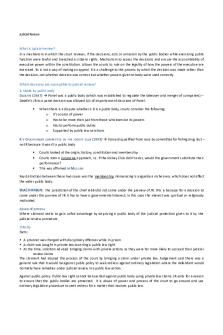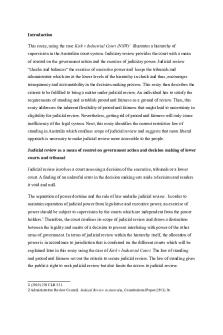ADMIN LAW Judicial Review PDF

| Title | ADMIN LAW Judicial Review |
|---|---|
| Course | Australian Administrative Law |
| Institution | Murdoch University |
| Pages | 5 |
| File Size | 147.8 KB |
| File Type | |
| Total Downloads | 70 |
| Total Views | 165 |
Summary
Lecture notes on Judicial Law in administrative law....
Description
PART 1: what is JR? Reminder: • Principle that official power should be exercised according to law, and not arbitrarily • The power of government is limited by the ‘rule of law’ – Separation of powers – Checks on powers – Executive action must be authorised by law • Judicial review: what is it and why have it? Protection: ‘Rule of law’ is protected in common law countries by various means. The courts: Separate from the executive and so have the power to scrutinise the actions and decisions of the executive. This process is called ‘judicial review’. • Political neutrality, the separation of powers and the limits of judicial review Separation of powers: – Needed for legitimacy: courts must be ‘politically neutral’. – Courts therefore cannot exercise merits review. Why? • The separation of powers requires that the courts are distanced from questions of the desirability, or ‘merits’, of government decision making. • The court does not generally have the power to ‘stand in the shoes of the original decision maker’ and make a fresh decision on the basis of all the relevant facts and circumstances of the case. • Can only look at ‘legality’. • Judicial v merits review Legality vs merits/best/preferable: • Merits = best or preferable decision (must still follow and comply with the law!) • Judicial review = courts consider only whether the decision-making process was sound, and the decision was lawfully made. • The judicial review process considers only the decision-making process Court’s role: Confined to determining whether the decision maker conformed to the rules and principles of administrative law. These rules and principles require that: • the decision maker is impartial • the decision maker does not exceed his/her power • the decision-making process is rational and founded on probative evidence • the decision maker makes the decision on the basis of relevant facts • the decision-making process allows a person, whose rights and interests are affected by the decision, the opportunity to be heard, particularly in relation to matters which are adverse or prejudicial. • Judicial v merits review: example Example: • Jane applies for a licence to operate a mobile beauty therapy business. As part of that decision, the DM looks at Jane's criminal history and notes that she has a
conviction for fraud in 2005. The statute requires that an applicant be a 'fit and proper' person for the purposes of obtaining a licence. The DM refuses Jane's application on the grounds of the criminal conviction. Questions: • Assume that the AAT has jurisdiction over this matter. If Jane applies to the AAT for a review of this decision, how would they approach it? • If the same decision were the subject of judicial review, how would the court approach it? • Judicial review limits – individual remedy The process of judicial review is only initiated if a person ‘affected by’ the decision seeks review. The court does not have the power to initiate judicial review of its own motion. “Courts do not have a mandate to seek out interesting and important questions of law and decide them irrespective of the desire of the parties to litigate. Whatever may be seen as the precise role of judges in making or declaring the law, it is limited in one vital, and salutary, respect: it can only be exercised in the course of deciding cases that are brought for judicial decision.” Gleeson CJ Re McBain; Ex parte Australian Catholic Bishops Conference (2002) 209 CLR 372, 390. • Judicial review limits – individual remedy Similarly, in Church of Scientology v Woodward, Brennan J said: "Judicial review is neither more nor less than the enforcement of the rule of law over executive action; it is the means by which executive action is prevented from exceeding the powers and functions assigned to the executive by law and the interests of the individual are protected accordingly." ((1982) 154 CLR 25, 70). • What can the court do if it finds the decision is ‘invalid’ or ‘illegal’? Declaration: • The court may declare actions and decisions taken by government legally invalid. Order decision to be made again: The original decision maker will have to make the decision again, on its merits, adopting an improved and lawful decision-making process. NOTE: decision might be the same! No substitution: The court cannot substitute a decision of its own for the decision being reviewed. • Judicial review: types and requirements 2 types of JR: (1) Common law – the old writs – 17th century (2) Statute – Administrative Decisions (Judicial Review) Act 1977 (Cth) (and some similar state legislation) 'Baseline' requirements are the same for both BUT you would look to statute for (2) and CL (decisions of courts) entirely govern (1). • Scheme of judicial review: the courts 1. Common law power: • The superior courts have an inherent common law power to exercise judicial review. • To initiate review, it is necessary to issue a ‘prerogative writ’.
Writs: – Mandamus – Prohibition – Certiorari – Also some others not often used e.g. habeus corpus • Scheme of judicial review: the ADJR Act 2. Power under the ADJR Act: • The Administrative Decisions (Judicial Review) Act 1977 (Cth) (ADJR Act) has: – codified the grounds of review and – simplified the remedial aspect of review. • HOWEVER: it has made the jurisdictional requirements of judicial review more complicated (see Tang – discussed in lecture part 3 ). • NOTE: The ADJR Act and similar state legislation (in Tas, Vic and Qld) does not abrogate or limit the inherent common law power of the superior courts to undertake judicial review of administrative decision making. • Baseline elements: what is required to initiate judicial review? (from Howe 3rd ed p. 133) 1. Jurisdiction – must have power/authority to review. 2. The disputed decision must be justiciable – it must be an appropriate decision and subject. 3. The applicant must have standing. 4. Ground of review: an applicant must be able to establish that the decision maker’s decision is unlawful in a recognised way. 5. Remedy: the applicant must meet the requirements to be eligible for a specific remedy – quash a decision (certiorari); prohibit an exercise of power (prohibition or injunction); order for the exercise of a public duty (mandamus); a declaration of the law. • Scheme of judicial review: the courts Only some courts may exercise judicial review: • the High Court (appellate court but also original jurisdiction in Cth matters); • the Federal Court (Cth matters) and • Federal Circuit Court (Cth matters); and • State Supreme Courts (state matters). NOTE: difference between original jurisdiction and appellate jurisdiction. • Commonwealth review The High Court – constitutional writs – types • The Commonwealth Constitution s 75 (v) guarantees the High Court’s original jurisdiction* to review decisions where: – a writ of mandamus (compelling the performance of a duty), – a writ of prohibition (preventing an exercise of power or jurisdiction) or – an injunction (restraining unlawful action) is sought against an ‘officer of the commonwealth’. *Remember: the High Court is also the highest appellate court from the Federal Court and state Supreme Courts in administrative law matters. •
•
• Commonwealth review The High Court – constitutional writs - why ? It can be seen that the HCA’s s 75(v) original jurisdiction ‘… is a means of assuring all people affected that officers of the Commonwealth obey the law and neither exceed nor neglect any jurisdiction which the law confers on them.’ See: Plaintiff S157/2002 v Commonwealth (2003) 211 CLR 476, 513 [quoted in Creyke & McMillan 2.2.33 (3rd edn); 2.2.43 (5th edn)]. • • • Commonwealth review The High Court – constitutional writs – certiorari Re Refugee Review Tribunal; Ex parte Aala (2000) 204 CLR 82: • Affirmed the view that the High Court may grant the prorogative writ of certiorari (set aside the decision) IF one of the named s 75(v) writs is sought i.e. the HCA has this power even though s75(v) does not mention certiorari. The Federal Court s 39B Judiciary Act 1903 (Cth): confers original jurisdiction on the Federal Court equivalent to the High Court’s jurisdiction under s 75(v), including its ancillary jurisdiction to grant certiorari and declaration. • The Federal Court effectively has the ‘jurisdiction to undertake judicial review of most, but not necessarily all, commonwealth administrative action.’ [See C&McM at 2.2.35 (5th edn)] • Federal Circuit Court • FCC does not share the Federal Court’s jurisdiction under s39B Judiciary Act. • Federal Circuit Court jurisdiction is conferred by the Federal Circuit Court of Australia Act 1999 (Cth): – Less complex Commonwealth administrative law matters – Expeditious – Limited formality – Cheaper (e.g. see ss 3(2) and 42 FCCA Act) – Utilises ADR incl mediation, conciliation and arbitration. • The FCC can review matters: – under the ADJR Act and – under Migration Act (review of decisions of the AAT). NOTE: appeals from the AAT to Federal Court can also be transferred to FCC. • •
•
Summary
Sharp differences between JR and MR – JR looks at the legality of the decision, not merits, so JR can be seen as less ‘powerful’ than merits review • Jurisdiction is important: – it is whether the court is empowered to review a decision – Consider the different courts and state versus Commonwealth: ADJR Act? CL? State equiv of ADJR? – Differentiate between original (e.g. s75(v) Constitution) and appellate jurisdiction. NEXT: jurisdiction to review is just the start. The court also needs to be satisfied as to whether the subject matter of the decision is something they should hear. So, what is ‘justiciability’? •...
Similar Free PDFs

ADMIN LAW Judicial Review
- 5 Pages

Judicial Review in Admin Law
- 11 Pages

Judicial Review
- 15 Pages

Judicial Review
- 50 Pages

Judicial Review
- 6 Pages

Judicial Review
- 40 Pages

Administrative Law - Admin Law
- 6 Pages

Judicial Review
- 7 Pages

Admin Law Exam ADJRA
- 10 Pages

Admin LAW - Subject Outline
- 9 Pages

Case discussion- admin law
- 13 Pages

Admin LAW - Important notes
- 44 Pages

Admin Law Summaries
- 47 Pages

Admin Law Theory
- 35 Pages
Popular Institutions
- Tinajero National High School - Annex
- Politeknik Caltex Riau
- Yokohama City University
- SGT University
- University of Al-Qadisiyah
- Divine Word College of Vigan
- Techniek College Rotterdam
- Universidade de Santiago
- Universiti Teknologi MARA Cawangan Johor Kampus Pasir Gudang
- Poltekkes Kemenkes Yogyakarta
- Baguio City National High School
- Colegio san marcos
- preparatoria uno
- Centro de Bachillerato Tecnológico Industrial y de Servicios No. 107
- Dalian Maritime University
- Quang Trung Secondary School
- Colegio Tecnológico en Informática
- Corporación Regional de Educación Superior
- Grupo CEDVA
- Dar Al Uloom University
- Centro de Estudios Preuniversitarios de la Universidad Nacional de Ingeniería
- 上智大学
- Aakash International School, Nuna Majara
- San Felipe Neri Catholic School
- Kang Chiao International School - New Taipei City
- Misamis Occidental National High School
- Institución Educativa Escuela Normal Juan Ladrilleros
- Kolehiyo ng Pantukan
- Batanes State College
- Instituto Continental
- Sekolah Menengah Kejuruan Kesehatan Kaltara (Tarakan)
- Colegio de La Inmaculada Concepcion - Cebu

